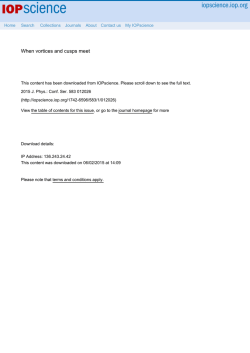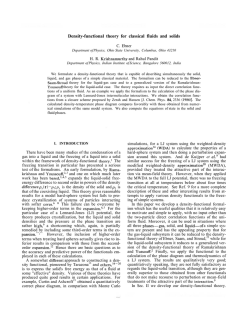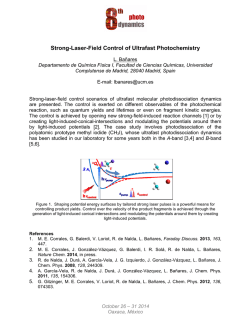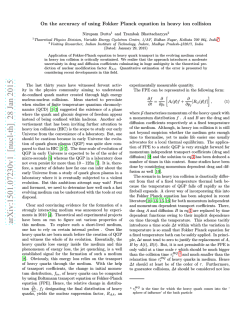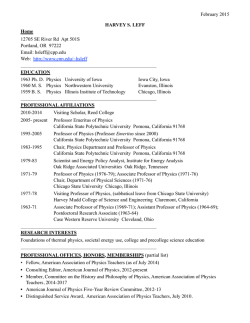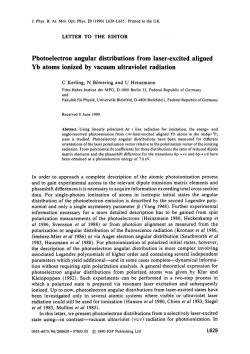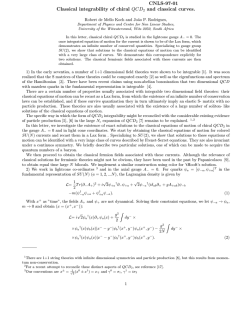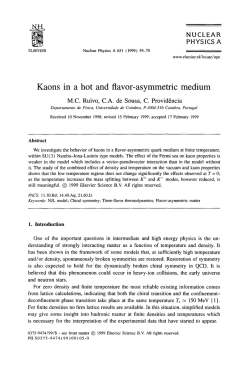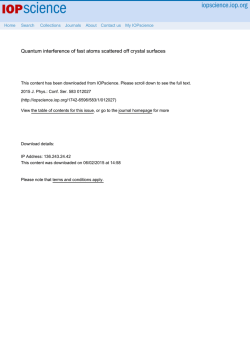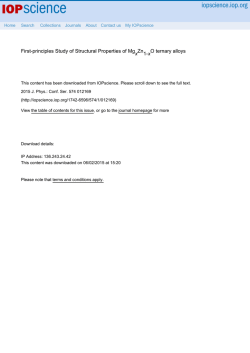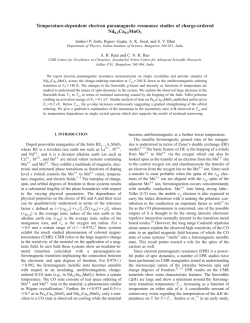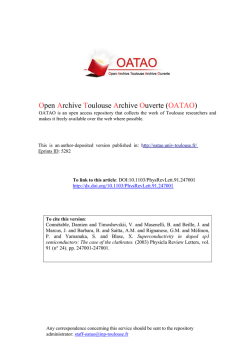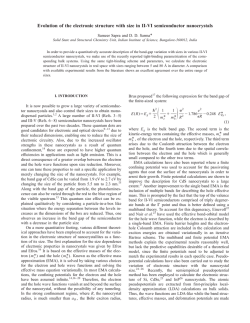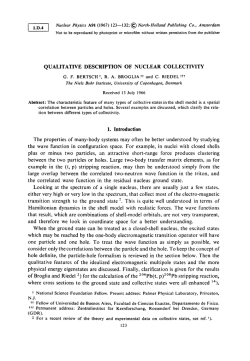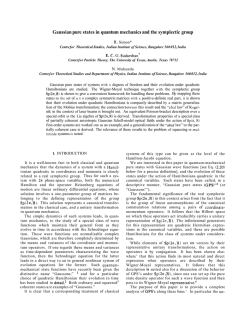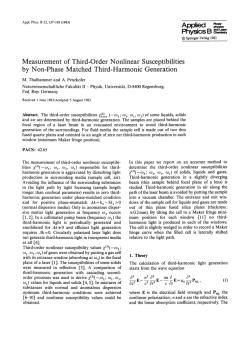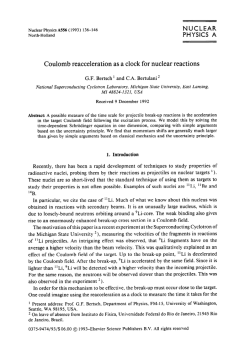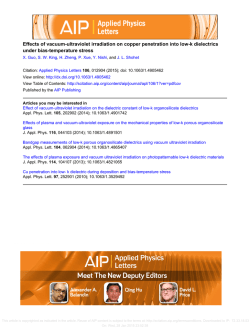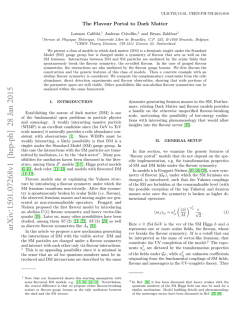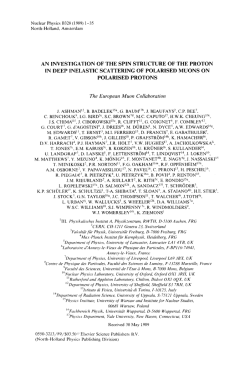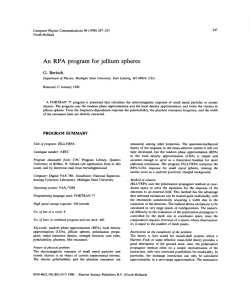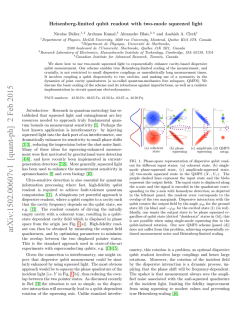
42. - Institute for Nuclear Theory
~
I
Nuclear Physics A249 (1975) 253 --268; ~ ) North-Holland Publishiny Co., Amsterdam
Not to be reproduced by photoprint or microfilm without written permission from the publisher
NUCLEAR HYDRODYNAMICS
G. F. BERTSCH +
Theoretical Division,
Los Alamos Scientific Laboratory, University of California.
Los Alamos, New Mexico 87544 **
Received 24 March 1975
Abstract: Continuum equations are derived for nuclear motion in the framework o f time-dependent
Hartree-Fock theory. The equations describe an elastic medium at low frequencies and independent particle motion at high frequencies. The giant quadrupole and monopole states are
derived from the theory. The quadrupole energy in the Fermi gas model is given by E = (h2/m)
(6k~/5(r2))~. The monopole energy depends on the details of the underlying Hartree-Fock
theory. For higher multipoles, the theory only gives a mean energy of the strength function. We
derive the Wigner density matrix of the theory. From this it is argued that all the modes except
the giant quadrupole and monopole are subject to Landau damping.
I. Introduction
To describe such complex phenomena as nuclear fission or heavy ion collisions,
it is essential that one deal with fewer variables than are contained in the many-body
problem. In classical physics, it is a simple matter to reduce the many-body problem
to hydrodynamics via the Boltzmann equation. For describing the dynamics of nuclei
the situation is not so simple because the mean free path of the particles is not small
compared to the size of the nucleus.
Nevertheless, much theoretical work has been done using hydrodynamic equations
as a model for the dynamics. In many cases the parameters such as compressibility,
viscosity are treated as adjustable parameters. It is important therefore to derive as
far as possible the continuum mechanics of finite Fermi systems, both to obtain the
form of the equations as well as the theoretical values of the constants that appear.
We shall first discuss a fundamental constraint on what can be accomplished by a
hydrodynamic description. From the hydrodynamic point of view, this constraint is
the equation of continuity. On the microscopic quantum mechanical level, the
constraint appears in the energy-weighted sum rules. We then derive the hydrodynamics
of the time-dependent Hartree-Fock equations. The result may appear disappointing,
for it does not give low energy vibrations or moments of inertia. However, in view
of the constraint we cannot expect to do better with the most basic hydrodynamic
t Permanent address: Department of Physics, Michigan State University, East Lansing, Michigan
48823.
tt This work performed under the auspices of the United States Energy Research and Development
Administration.
253
254
G.F. BERTSCH
variables. Following this, we discuss the dissipative mechanisms in the Fermi system.
The Landau damping is well understood in the framework of the quantum mechanical
Boltzmann equation, but the subject of collisional damping is still open.
2. The equation of continuity
The type of equations we wish to derive will certainly involve as field quantities
the mass density p and the momentum density p. For a more complete description,
other variables might be required in addition. Examples are the strain tensor, deformation of the Fermi surface, or the pairing field. In any case, we would expect the theory
to have p and p as fundamental field quantities, and that the equation of continuity
would be satisfied. This is
- '~--P= v . P .
~t
m
(1)
Classically, the equation of motion is derived by combining this with an equation
for the force on the medium,
dp
dt
e(p . . . . ).
_
(2)
In the simplest case, F is the gradient of a scalar,
F = VP,
(3)
and the equation for ordinary sound may be easily d e r i v e d
33).
Turning to the quantum mechanical problem, we may derive the same equations
with the usual definitions o f p and p:
p(r, t)
= ~
pi(r, t),
(4)
i
where
p,(,., ,) -- f dr, . . .
drN
(5)
p(r, 0 = Y~ P,(~, t),
i
where
pl(r, t)---- f dr2 • • • drti ~/[~b*V1 ~ - (V1 ~/*)~b-].
Here
tion,
I]/(r 1 . . .
rN, t) is the many-body wave function satisfying the SchrSdinger equa-
- ,~" 2n--~
'
dt ~b.
(6)
We prove the equation of continuity by using the SchrSdinger equation to evaluate
NUCLEAR HYDRODYNAMICS
255
@/~t.
This simple exercise, which should be familiar to most readers t), goes as
follows:
!
8t
I.J
=
OrN[~b*V~b-(V20)*O]
-
2m i
= - V - - - f d r 2 . . . d r N [¢,*V,
m
O-(V, ¢')*0]
2i
= -V.p,/m.
(7)
In the same way, we can evaluate the time derivative of the momentum density to
obtain an equation of type eq. (2). The left hand side is rather complicated; it is not
in general the gradient of a scalar as is required for ideal fluid behavior. To make
further progress, we must impose a specific model of ~k. This will be done in sect. 3.
Before proceeding, it is useful to derive generalized energy-weighted sum rules z, 3)
from the equation of continuity 4). The sum rules are relations involving matrix
elements of position operators between eigenstates of the Hamiltonian:
(E~-Eo)(@ol~(x)l¢~><O~lM(r)l~o> =
-1
2m
Vx" <¢0lVM~(x)[¢0>.
(8)
Here ~3(x) is the density operator, with matrix elements defined in eq. (4), and the
sum is over all excited states of the system. Also, M(r) is an arbitrary function of
position, such as r2Y2(r),jo(kr), etc. To derive the relation, we start with the system
in the ground state and excite it with a weak impulsive potential of the form
V(r, t) = M(r)6(t- to).
(9)
In terms of the eigenstates of the Hamiitonian, the wave function after t o is
¢' -- 1¢'o>+ ~ <¢~oIMIG> e-,~-EO),lG>.
(10)
i
We now calculate the rate of change of density just after to:
dp
dt
-
2 ~(E=-Eo)<~kolMl~k=><~k=l~(x)l¢o>.
(ll)
The divergence of the momentum field is similarly expressed,
V'p_
m
--Iv.
~ <~ko[Ml¢,>
im
•
~,fjI~I~idarj[(V'~k:)~b~-¢:ViO~]
~
2i
V
= - - " <¢ol~(x)[VM'llOo>.
171
(12)
256
G.F. BERTSCH
We have used completeness in the last step. The equation of continuity then requires
that the left-hand sides of eqs. (11) and (12) be equal, which is just the sum rule
eq. (8). The standard sum rule 5) is obtained by integrating both sides of eq. (8)
with SdxM(x),
(EP_Eo)(~JolMl¢,~)2 = 1 1 (~ol(VM)2l¢,o)"
2m
(13)
Of course, this could have been derived directly from the Schr6dinger equation
without using the equation of continuity. The purpose of the demonstration was
to show that a hydrodynamic theory, with the usual interpretations of p and p,
must produce excitations satisfying the sum rules. Empirically, the low-lying collective excitations in nuclei typically have only a fraction of the sum rule strength. The
lowest quadrupole excitations, for example, typically exhaust 5 ~o of the sum rule 6).
The low-lying collective octupole has a similar fraction of the octupole sum. Therefore, as Lane 5) observes, these states cannot be described by a simple hydrodynamic
theory. Only by going to a multicomponent fluid description could one hope to have
a comprehensive description. It is an important unsolved problem to elucidate the
continuum theory of these lower states, because they play an important role in the
dynamics of fission.
3. Dynamics of Hartree-Fock theory
A simple quantum mechanical model which displays interesting dynamics is timedependent Hartree-Fock theory. Another study of this theory somewhat related to
ours is given in ref. 40). The many-body wave function is approximated by a determinant of single-particle wave functions ~ . The ~k~are solutions of the Hamiltonian,
i d ~k, = ( - v~ + V [ p ] - e , ) ~b,.
dt
2m
(14)
The e, are determined by the time-independent solutions. These solutions, which we
refer to with a superscript zero, give the ground state wave function. We also make
use of the ground state density,
Po = E I~bl°)[2"
(15)
i
To impart motion to a system initially in its ground state, we multiply each singleparticle wave function by the factor e ~'~¢, where ~ is an arbitrary real function of
coordinate and time. The wave function will then acquire a momentum density
p = mpoV¢,
(16)
with
¢,(r) = e'm:~b~°).
Thus ~ may be interpreted as a velocity potential. With the phase factor e ~¢ the
system has been given a coherent velocity field, but its density is still the same as in the
NUCLEAR
HYDRODYNAMICS
257
ground state. To describe density changes, we shall have to modify the wave function
in a different way. In the theory of the Bose quantum liquid, it is sufficient to multiply
the single-particle wave function by a real function, R(x). The density variable is R’,
and the hydrodynamic theory follows easily ‘). This method is inadequate for the
Fermi system, because the nodes in the wave functions are unchanged by multiplication. A more useful method is to consider the coordinate transformation on the wave
functions,
tji(r) = Il/i’)(r+V@).
(17)
However, the transformation (17) is insufficient because it does not conserve the
normalization of the wave function. This may easily be seen for the case where @
is a stretching field. Then r,Gcovers more volume but since its magnitude is the same,
the integrated probability must be larger. The normalization can be conserved for
small SDby using the following transformation instead:
We shall now assume that the changes in the wave function are small. We may then
expand the single-particle wave functions+
eime
(20)
The density is expanded to first order in @ as
where
sp = (V@) * vp, + (V2@)po.
The continuity equation requires that
dp --=d@
dt-
dt
--Ivy
Jn
=
-V.pV&
(22)
This equation can be satisfied with the density of eq. (21) if only
5 = -d@ldt.
(23)
We now derive the equation of motion by applying the Hartree Hamiltonian, eq.
(14), to the wave function (20). The imaginary part of the resulting equation is equivt The reader may be concerned about violations of the Pauli principle in these wave functions. In
fact there are none, because all the wave functions are changed the same way. Algebraic details
showing the cancellation of Pauli-violating terms are given in ref. ‘I).
G. F. BERTSCH
258
alent to eq. (23). The real part of the Hamiltonian
equation yields
The last term arose from the time-dependent part of the Hartree-Fock potential,
V[p]. Obviously, these equations cannot all be solved simultaneously for one function
@. The best we can do is to solve them in some average sense, by adding together the
equations for the different orbits, suitably weighted.
We shall also assume that @ has a harmonic time dependence,
@(r, t) = Q(r) sin or.
This assumption, together with the small amplitude assumption, reduces the
general time-dependent Hartree-Fock theory to RPA “). With the further assumption
that all the particles are governed by the same velocity potential, the theory reduces
further to its hydrodynamic limit. This encompasses only the spin-independent,
isoscalar excitations of the nucleus. To include spin or isospin degrees of freedom, we
would need to consider independent velocity fields for particles of different spin and
isospin projection.
First let us simplify the appearance of eq. (24) somewhat with the notation
u = V@.
(25)
Since 4 is a velocity field, u may be interpreted as a field of displacement vectors.
Making use of the ground state condition,
(26)
( -V2/2nZ + V[pO] -&i)~lO’ = 0,
the first term on the right-hand side of eq. (24) becomes
(- g+v[po]-ci)
(I4 ’
_
c
as
VpqO’++(V* u)lg”‘) = -
$ *vlg”’
v,$I”’ _ V2P
4m- u) $i
(Vm
“&
(0)
-u
* (VV)tgO’.
in
(27)
To reduce eqs. (24) to a single equation, we multiply (24) by
(u . Vlp’++(V
. u)lp)*
and sum over occupied orbits +. We then integrate over the space coordinate.
(28)
The
t The choice (28) for a weighting factor may seem quite arbitrary. We use it because the result
comes out simply, and because the result is equivalent to using Thouless’ RPA variational principle”‘).
NUCLEAR
259
HYDRODYNAMICS
result for the left-hand side of the equation is
J
i
This is integrated by parts to obtain
$0*
s
mp, u . u d3r.
(29)
Interpreting ou as the velocity vector, this is no more than the kinetic energy, as an
integral over the kinetic energy density. The right-hand side of our equation is
(I
1 r
I[u] = - kj d3r(uV$~o)+f(V
* u)$I”‘)*(2(v2u) * vi@‘+2 1 (V, us)Volv, I@’
B
+J(V’V
. u)$i”‘+2m(VT/)
* u$i”)-22nz Ebp$j’)),
(30)
where the derivative operators act only on the function immediately following them.
Before reducing this further, we shall make some general observations. The
equation may be solved for 02,
(jJ* =
lCu1
tnzju-upod3r’
This equation is just Rayleigh’s variational principle ‘) for the vibrational energy,
if we interpret 1[u] as the potential energy associated with a trial displacement u.
In fact, it can be shown from Thouless’ variational principle lo) that eq. (31) is a
quantum mechanical upper bound on the energy of the lowest RPA mode Ii).
This may be considered the justification for our reduction procedure. Treating (31)
as a variational principle, we can recover a differential equation for u by standard
techniques 12). However, it is more transparent to keep the dynamic equation in
integral form.
To simplify the expression for the potential energy 1[u], we shall replace the square
of the wave functions by the density,
c W1°)12= PO,
T (V, l/G;“‘)*lg”’=
+v,p.
(32)
Furthermore, we shall assume an isotropic momentum tensor, so that second and
third derivatives on the wave function are evaluated as+
(33a)
7 (V, +IO))*V, $I”’ = &, K,
c (V, Vb${‘)*)Vr $i”’ = +s,, V, k’+ $8,, V, K -
+v, KC&~,
W)
I
c
$;")*VaVB$iO)
= +V,VBP-6,8K.
WC)
* The derivation in ref. I’) erred by a factor of 2, because only one term was considered in (33b).
260
G. F. BERTSCH
Here K is a function of position; in the Fermi gas model
In the expression for I, we integrate by parts whenever a gradient of the density or
the momentum tensor occurs, to make the final expression less dependent on surface
quantities. The resulting expression for I contains terms of three types, depending on
K, p and the potential, respectively,
I = 1,+1,+1,.
(35)
The algebraic expressions for these terms are:
I, =jd’r;
I, =
s
[$(~)z-+~V2~]
,
(36)
d3r~~-!(V.*)V2V.U+f~V=VB((V..)V,uS)
(37)
(38)
Let us examine the physical significance of these terms in more detail. The second
derivative term may be compared to the potential energy function of the theory of
elasticity, which is given by 13)
v
=Jd3r
[+i(V*~)~+pz
(2)‘]
.
B
(39)
Comparing this with eq. (34) we see that the elasticity parameters due to the singleparticle kinetic energy in Hartree theory are
The quantum expression has an additional term proportional to uV2u, which has no
classical analog.
We can understand the necessity of the fourth derivative term, I,, if we note that
the theory is asymptotically correct in the high momentum limit, where
u = V sin q - r,
q>kF.
(41)
Then the excitation energy must equal the single-particle kinetic energy:
rB2 = (4 2/2m)2.
(42)
NUCLEAR HYDRODYNAMICS
261
It may be easily verified that eq. (31) with Ip evaluated from eq. (37) gives just this
limit.
Finally, we turn to the potential energy term. This can be simplified in the limit
of short range interactions, whence
V V = __6
V Vp,
(43)
6V
6V
Iv ~ f da r (½p2(V " u)2 ~p +½p(V " u)u " V p ~ p ) .
(44)
6p
and we find
Unfortunately, the surface term cannot be eliminated because of the dependence of
6V/6p on position. The first term has the form of an elastic potential, with moduli
21,, = 192 -~- V ,
6p
.¢
= 0.
(4s)
Before applying the theory to a realistic nuclear equation of state, it is instructive
to consider the simple example of a single particle in an external oscillator well.
The fields Uo = ½Vr 2 and u2 = V(r 2y2) create eigenstates of the system-namely the
2 hto excitations of the ground state.
The ground state wave function and Hamiltonian may be chosen as
~{o)= Ne-t,,, ~,
(46)
~72
V2 )
----+--r
2 .
2m
2m
H=
The oscillator energy is given by
~oo = v/rn.
(47)
Let us now substitute the monopole field in eq. (31). We find for the kinetic energy
½mr p u" u dar = 3m/4v.
i/
(48)
The potential energy is calculated as
K=~v2r2p,
2am
]r = --3 --V,
2m
Ip = O,
(49)
r . r V " (rp)da r = 3v_~ .
2m
Substituting in eq. (31),
, ~ _ (vlm)(~} + { ) = (2a, o)L
~}mlv
(50)
as it must. Half the collective potential energy was actually kinetic energy of the
262
G . F . BERTSCH
single-particle wave function, and half came from the external potential. The quadrupole field VrZY 2 gives the same result.
We now see why the elastic modulus 2 must not depend on the single-particle kinetic
energy. The coefficient of the modulus 2 vanishes for the quadrnpole field but not
for the monopole. If 2~ :/: 0, the L = 2 and L = 0 oscillator states would have different energies.
We also gain an understanding of the simple result of the self-consistent oscillator
model,
(0 = 4
(0o.
(50
This was derived by H a m a m o t o 14) for the quadrupole and by Suzuki ~s) for both
the quadrupole and monopole. The calculation includes the single-particle kinetic
energies, I n, but the self-consistent approximation used in effect assumes that the two
terms in eq. (38) for 1v cancel completely. It is then obvious that (02 will be half o f
(02 for both L = 0 and L = 2. The result (51) is reasonable for L = 2, but not for
L = 0, since 2 v is non-vanishing. Zamick has treated the residual interaction more
carefully in the oscillator model 16). He shows explicitly that the quadrupole energy is
independent of the interaction if it is short range, and that the monopole depends
very much on the interaction.
Let us now apply the hydrodynamic theory to the lowest multipole excitations.
The classical theory of oscillations of a sphere gives the lowest monopole frequency
as t8)
(02 _ 2 + 2 # 6.57
P
R2
(2 =/~),
where R is the radius of the sphere. The displacement vector u satisfies
u = Vjo(qr ),
with
q2 = (02 2+2/~
P
Various authors have constructed hydrodynamic 19-22) and other collective models 3 7 - 3 9 ) of the nuclear monopole vibration. Many early treatments postulated
that the potential energy of the collective mode is determined by the bulk modulus
o f compressibility of nuclear matter. For example, Zamick 22) writes for the monopole
h2 K
o~2 (52)
m (r2> '
where K is the bulk modulus. The bulk modulus K is defined t
K = 9V 2 aE/A
OV2
9 k_.
p
* Realistic theories tT. 24, 2s) and the Thomas-Fermi analysis of the liquid drop formula a4) give
K in the range 200-300 MeV.
NUCLEAR
HYDRODYNAMICS
263
The relationship with Lame’s elastic constants is
k = L+&L
Let us examine this relationship in more detail. In a Hartree-Fock
energy per particle is
3 h2
E/A = -5 -2m
theory the binding
k;+~bl,
where Y is the potential energy per particle. The bulk modulus in such a theory is
k
d
-=-p
P
aP
z aE/A
-=ap
2 h2
-k;+2pax
3 2m
+p’--.
a2v
dP
ap”
To relate this to the present theory, we write the Hartree-Fock
the potential energy,
v =
(53)
potential in terms of
avplap.
Then the “bulk modulus” as given by the elasticity parameters is
I
a2v + ??k2
=
p
2p*x
+p2---k,, = &+~cL,
ap
ap2 15 112 F .
This is nearly identical to the classically derived bulk modulus, eq. (53).
Let us now make an estimate of the monopole frequency, using the trial velocity
field u = $Vr2. With this choice IP vanishes. We find
T = _5m p. r2 d3r = gm(r2)A,
s
I,=2
m
Iv = 5
I
S(
Kd3r z3$A,
9p2 ‘-’ +3pr * Vp !f?
6P
6P
Short range interactions that saturate nuclear matter seem to have a change in sign in
SV/6p in the surface region. We will therefore neglect the second term in 1”. Then
and the monopole frequency is
=___ 9
km
m<r’> P
(55)
This is identical to Zamick’s formula, eq. (52). Let us now make a numerical estimate.
264
G. F. BERTSCH
According to the interactions I and II of the Hartree-Fock
Brink “), the parameter 1 is
1
_=,sv=
P
JP
theory of Vautherin and
17.0 MeV,
Skyrme I
( 14.6 MeV,
Skyrme II.
We estimate the mean square radius of the nucleus as r2 = 3(1.2)“&.
stituted in eq. (55) and the monopole frequency is
ho, = 5
MeV,
ZtoII =gMeV
A+
This is sub-
*
The actual solution of the RPA equations 23) for these interactions gives an isolated
monopole state. In Pb, the frequency is about 10 % higher than given by eq. (56).
We now estimate the giant quadrupole energy. The classical theory is quite complicated, since the shearing field is coupled to the compressive field by the boundary
condition at the surface. Again, we shall be content with a numerical estimate based
on the trial velocity field,
u =
V(z2-+x2 -$y2).
(57)
Both Ip and ly vanish, and we are left with the simple formula
(Jg =
6k;
5m2(r2)
’
Numerically, this becomes
A@,,, = 66/A*,
which is in reasonable agreement with the oscillator model, eq. (51). The empirical
energy of the giant quadrupole is closer to 60/A* MeV.
4. Dissipation
In the preceding section we derived an equation for the displacement vector u
of nuclear motion, assuming that all the particles move coherently. In fact the particles
lose coherence, either from differences in single-particle energies or from collisions,
so that eq. (31) can only describe some average frequency associated with the displacement field u.
The dissipation of energy into the single-particle degrees of freedom, known as
Landau damping, can be treated within the framework of time-dependent HartreeFock theory. The damping due to collisions is more difficult and we defer consideration until later.
A formalism general enough to include both the hydrodynamic RPA and damping
effects is given by the quantum Boltzmann theory, based on Wigner’s representation
NUCLEAR HYDRODYNAMICS
265
f(r, p, t) = J dx' elp" x'(~k*(r + ½x')~k(r- ½x')),
(59)
of the densityt matrix 26)
where the ~k are nucleon field operators, and the expectation is in the time-dependent
state. This function satisfies a Boltzmann equation 27),
+ P " Vxf = collision term.
Ot
(60)
m
If there is no interaction and the left-hand side vanishes, thenf(x, p, t) = f ( x - ( p / m )
t, p) and the particles propagate ballistically. The time-dependent Hartree theory can
be obtained by considering an independent-particle limit of the collision terms. The
equation then reduces to the Vlasov equation 2 s),
~t
+ P" V ~ f - V v f " Vx~ Vd3pf(R, p) = 0.
d
m
(61)
We shall now display hydrodynamic RPA in this formalism. First consider the
density matrix in the interior of a nucleus in its ground state. The functionf(r, p, t)
is roughly a constant within a sphere in p-space, and zero outside,
f(r, p, t) ~-. O(IpJ-pr)f(r).
(62)
We now apply the familiar transformation to the wave function
~k'(r) = e -'m6 ~k(r+V~)
x/1 - V 2 ~ "
(63)
The new expectation of the field operators is
( ¢, +(r + ½x) ,(r-½x) )'
= e_,m6(,_~rx)+,mdC,+~rx)(¢+(r+½x+V#(r+½x))O(r-½x+V~(r-½x))
(64)
1 --V2~/)
We expand ~ and V# to first order in x, and change the integration variable from
x to x' = x + Vc/,. The distribution function then becomes
f'(r, p, t) = f d x ' e 'Cp-v" vvo- mv(~).x'(~+(r + ½x' + V#(r))~,(r - ½ x ' + V#(r)))
,-~ O(Ip-p" VV#-mV~I-PF)f(r + V~(r)). (65)
Next we assume that the change in the distribution function is small, so that we may
expand it as follows
f ' = fo+J(lp[--PF)(P" V(p" V # ) + m p " Vt~).
t I am indebted to P. Carruthers zs) and J. Negele for pointing out to me the usefulness of this
object.
266
G.F. BERTSCH
Inserting this in the Vlasov equation, and keeping only the first order term, we find
t~(lPl--PF)(p'V(~" Vq~)+,n~- V ~ ) + ( ~ n - V ) ( - - p " V(/~" V~)+m/~- V~b)
= 6(IpJ-pr)P"
Vfd3p
Vfi(Ipl-pF)(p" V(P" V~P)+mp • V~).
(66)
The terms with ~ cancel out on the left-hand side, and vanish when integrated on
the right-hand side. We could now derive the hydrodynamic theory by integrating out
the dependence on the direction of the momentum vectors, p. Instead, let us examine
under which conditions the dependence on p can be neglected. This will tell us when
the mode retains coherence. The form of the equation is
, , p . v ~ + _n. v ( - p . v)(p • v)+ = p . v v [ + ] .
(67)
m
This can only be satisfied for all p if the second term on the left can be neglected.
The collective modes of the Landau theory emerge when U is repulsive. Clearly, for
large repulsive U, the frequency is high and thus the/~3 t e r m can be neglected. However,
more relevant for nuclear motion, the p3 will vanish if • is a quadratic function of r.
Thus the giant quadrupole and giant monopole should be undamped in this theory.
Empirically, the quadrupole is observed as a fairly well defined mode having 50 % of
the sum rule in medium to heavy nuclei as, 36). Physically, the reason for the stability
of the mode is that the distortion of the Fermi sphere is uniform throughout the
nucleus. Then the ballistic propagation of particles does not lead to a loss of coherence.
Note that except for these special cases, damping will be severe. The ballistic propagation of the particles damp out any spatially non-uniform distortion of the Fermi
sphere, on a time scale of the order t ,,~ mL/pF, where L is a length characterizing
the spatial scale of non-uniformity. This is at variance with the usual notion of viscosity, which implies a damping time of the order of
t = pL2/v,
where v is the coefficient of viscosity.
In the Hartree-Fock treatment the off-diagonal interaction between the particles
has largely been ignored. The incoherent treatment of this gives another damping
mechanism. The theory is well developed for infinite systems at finite temperature 29- a ~).
Using the Boltzmann equation, one finds the expected result that the rate of energy
dissipation is proportional to the energy in the collective mode. The dependence on
the wavelength and frequency of the mode is given by
dt-
dE
cE ( vFq)2'
-~ /
where VF is the Fermi velocity. At zero temperature, the damping can be calculated
NUCLEAR HYDRODYNAMICS
267
by the Golden Rule with a microscopic treatment of the states and the interaction,
F = 2r~(collective ]VI2p-2h)2p2p2h .
Qualitatively it is found that the decay rate of collective oscillations in uncharged
systems is 33)
r ~,
C 0 q ~ q 2.
For the charged Fermi gas, Dubois 32) has calculated the damping of the plasmon.
Here the dependence of q and ~Oqis
2 2.
I" , ~ (,oqq
Presumably the collective excitations can be treated independently in a state with
many quanta excited, so that the rate of energy dissipation is proportional to the
number of quanta and therefore the total energy in the collective mode. Unfortunately,
if we apply the Boltzmann theory to systems at zero temperature, this simple result is
not obtained. Because of the density of states at zero temperature, the damping is
proportional to the fourth power of the deformation. Thus even the linearity of the
hydrodynamic theory is brought into question. Clearly more work remains to be
done in this area.
The author thanks K. Stricker for valuable assistance.
References
1)
2)
3)
4)
5)
6)
7)
8)
9)
10)
11)
12)
13)
14)
15)
16)
17)
18)
19)
20)
21)
L. Schiff, Quantum mechanics (McGraw-Hill, New York, 1949) p. 29
J. V. Noble, Ann. of Phys. 67 (1971) 98
T. Deal and S. Fallieros, Phys. Rev. C7 (1973) 1709
G. Bertsch, Phys. Rev. C10 (1974) 933
A. M. Lane, Nuclear theory (Benjamin, New York, 1964) p. 80
M. Mariscotti, G. Scharff-Goldhaber and B. Buck, Phys. Rev. 178 (1969) 1864
E. P. Gross, J. Math. Phys. 4 (1964) 195
A. M. Lane, Nuclear Theory (Benjamin, NY, 1964) p. 107
J. W. S. Rayleigh, Theory of sound (Dover, New York, 1945) p. 109
D. J. Thouless, Nucl. Phys. 22 (1961) 78
G. Bertsch, Ann. of Phys. 86 (1974) 138
H. Sagan, Boundary and eigenvalue problems in mathematical physics (Wiley, New York, 1961)
I. Sokolnikov, Mathematical theory of elasticity (McGraw-Hill, New York, 1956) p. 85
I. Hamamoto, Proc. Conf. on nuclear structure studies using electron scattering and photoreactions, Tohoku Univ., Sendai, Japan (1972) p. 205
T. Suzuki, Nucl. Phys. A217 (1973) 182
L. Zamick, preprint
D. Vautherin and D. Brink, Phys. Rev. C5 (1972) 626;
J. Negele and D. Vautherin, Phys. Rev. C5 (1972) 1472
H. Lamb, Proc. London Math. Soc. 13 (1882) 192, quoted by A. Love, Mathematical theory of
elasticity (Cambridge University Press, Cambridge, 1927) p. 285
J. D. Walecka, Phys. Rev. 126 (1962) 653
C. Werntz and H. ~berall, Phys. Rev. 149 (1966) 762
V. Pandharipande, Phys. Lett. 31B (1970) 635
268
22)
23)
24)
25)
26)
27)
28)
29)
30)
31)
32)
33)
34)
35)
36)
37)
38)
39)
40)
G . F . BERTSCH
L. Zamick, Phys. Lett. 47B (1973) 119
G. Bertsch and S. Tsai, Phys. Reports 18 (1975) 126
X. Campi and D. Sprung, Nucl. Phys. A194 (1972) 401
S. Coon and H. K6hler, Nucl. Phys. A231 (1974) 95
E. P. Wigner, Phys. Rev. 40 (1932) 749
L. Kadanoff and G. Baym, Quantum statistical mechanics (Benjamin, New York, 1962) p. 70
P. Carruthers and F. Zachariason, preprint
A. Abrikosov and I. Khalatnikov, Rept. Prog. Phys. 22 (1959) 329
L. R. Corruccini et al., Phys. Rev. 180 (1969) 225
C. Pethick, Phys. Rev. 185 (1969) 384
D. F. DuBois, Ann. of Phys. 8 (1959) 24
E. Glassgold, W. Heckrotte and K. Watson, Ann. of Phys. 6 (1959) 1
W. Myers and W. Swiatecki, Ann. of Phys. 55 (1969) 395
S. Fukuda and Y. Torizuka, Phys. Rev. Lett. 29 (1972) 1109
M. Nagao and Y. Torizuka, Phys. Rev. Lett. 30 (1973) 1068
S. Wong, G. Saunier and B. Rouben, Nucl. Phys. A169 (1971) 294
]-I Flocard and D. Vautherin, Phys. Lett. 55B (1975) 259
S. Krewald et al., Phys. Lett. 55B (1975) 267
Y. Engel, D. Brink, K. Goeke, S. Krieger and D. Vautherin, Oxford Univ. preprint
© Copyright 2026
